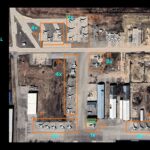Yesterday night, an air attack destroyed an Iranian logistics node near Abu Kamal (Syria). The likely culprit behind the attack is the Israeli Air Force (IAF), since Jerusalem has recently expanded air operations to Syria’s border region and even Iraq. The strike was allegedly conducted by F-35Is “Adir” (Israeli-modified F-35As). The Iranian logistical support operations hub in Abu Kamal had been established earlier this year.
The Israeli geospatial company ImageSatIntel (iSi) recently released a battle damage assessment of an earlier IAF raid on the same facility, which took place on September 8, 2019. The analysis accounted for a total of eight storehouses that were completely destroyed. The structures were part of a wider military base, codenamed “Imam Ali” compound, which has been built and financed by the Iranain Revolutionary Guards Corps-Quds Force for the purpose of weapons storage. The logistics node likely hosted missiles, small weapons, rocket launchers, and ammunition smuggled to Syria from Iran and Iraq.
The attacked storehouses are located in a military base (#Iranian, according #FoxNews), 5 km West of the Syria-Iraq border of #Albumamal–#AlQaim. The mentioned border is still closed, but it seems to be ready to be #operarional soon. pic.twitter.com/KkDNrHFfxT
— ImageSat Intl. (@ImageSatIntl) September 9, 2019
Abu Kamal is located on a strategic border crossing between Syria and Iraq. Iranian-backed forces seized the area from ISIS in mid 2017. For Iran, control over the Abu Kamal area is key to solidify the “Shia Crescent” line of communication that links the Iranian homeland to Syria and Lebanon via Iraq. This “land bridge” diversifies Iran’s logistics routes, as the IAF continues to prosecute Iranian air transports to Syrian airfields.

Iran’s “Shia Crescent” land corridor visualized by T-Intelligence
Cover photo: The F-35 Integrated Test Force is completing a series of night flights, testing the ability to fly the jet safely in instrument meteorological conditions where the pilot has no external visibility references. The ITF, which has the lead on all F-35 mission systems testing, is responsible for five of the six night flights. (Courtesy photo)
- Russia Bombs Maternity Ward & Children’s Hospital in Mariupol As Part of Siege - 10 March 2022
- T-Intell’s OSINT Training Marks One Year Anniversary - 18 November 2021
- IS-K Never Left the Battlefield - 27 August 2021






